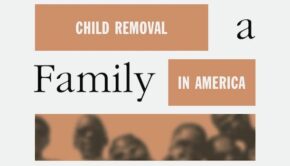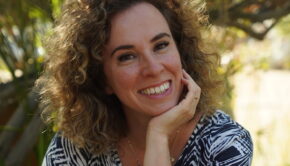“Free, Equitable, Joyful”: Artist Molly Allis Draws a Better World
In 2017, the Twitter account @polNewsNetwork1 posted a photo of two subway riders. One wore a black burqa and puffer jacket, the other wore a short teal dress and voluminous orange wig on a body most onlookers would have declared male. The caption–“This is the future that liberals want”–quickly backfired. A future in which different types of people can chill together on public transportation? Yes, please.
Multimedia author Molly Allis’ new picture book in English and Spanish, Hooray, What a Day! / Viva, Qué Día!, takes this concept to its hypercolor conclusion and imagines what it would be like to grow up in such a world. Frankie, the book’s nonbinary, green-skinned, lavender-haired narrator, skateboards past bookstores and a bike collective, joins a parade of mermaids and stilt-walkers, harvests onions and sweet potatoes from the community garden, and writes their own story in a zine-making workshop.
Like many children’s books, Hooray celebrates everyday adventures and comforts. Unlike most books of the past and many in the present, it suggests this territory is not just for cis white children in suburban nuclear families (with, you know, one Black kid parked in a wheelchair in the background).
Allis spoke with MUTHA about the intersection of art and community, working with kids, and their love of Ira Sleeps Over.

What inspired you to write Hooray, What a Day! / Viva Qué Día!?
Hooray, What a Day! / Viva Qué Día! came out of a public art project I made a few years ago called The Storytelling Machine. It told a bilingual children’s story through a series of kinetic boxes that you could look into and move elements of the scenes using levers, cranks and other mechanisms–kind of like a pop-up book. But ultimately, Hooray, What a Day! / Viva Qué Día! was inspired by different times in my life where community, art, music, and DIY skill sharing helped me thrive and connect with the people around me, and helped me feel part of something larger than myself.
I used to be in a radical brass band in NYC called the Rude Mechanical Orchestra that played music at protests. I’ve spent many years teaching people how to make sculptures and puppets and express themselves using recycled materials like cardboard and other things that would otherwise be thrown away. So the world of the book comes from a lot of that. And the desire to help create a joyful queer world that celebrates community and chosen family.
I appreciate that Frankie’s nonbinary gender identity is somewhat incidental, as opposed to the focus of the story. Was that intentional?
As someone who feels like I don’t always have the right language to talk about my gender, I think it came from an organic place of wanting to show characters whose genders are more ambiguous and fluid, without necessarily having to explain why. And while I think it’s important to create more queer representation in general, I also think it’s nice when queerness is a jumping off point for telling other stories that don’t necessarily focus on queer identity. Being queer is just one part of my identity, and while it’s really important to me, there are so many other ways that I like to connect with people based on different parts of myself. So I tried to make space for queerness being just part of the world of the story, but the story ultimately being about celebrating community and connection.

One of the characters you’ve illustrated carries a sign that says “Otro mundo es posible.” It feels like you’ve created that other world in these pages. What elements and values did you decide to include in this world, and why?
I wanted to show a neighborhood or place where people live in community by sharing resources with each other (like food from the community garden), creating art and performances that are public and free (the street band), teaching each other how to learn new skills (like making zines), and having a fun time while doing all of it.
I would love to live in a world where art is public and free and everyone makes it and there’s no separation between people being artists and non-artists. I think we are all creative and all can express our voices through art in important ways. I also want to live in a world where we have found ways to share our resources so that everyone has what they need. That’s related to showing a DIY skill share for zine making in the book–showing that we can make really great things using what’s around us, often without having to spend money.
How did your work creating art with kids inform this project?
Working with kids has been a very rewarding extension of my own art practice around taking trash and turning it into something magical and meaningful and valuable and beautiful. Kids are the best at using their imaginations to imagine how the world around them could be different. That definitely informs the world of this project–the idea that if we can all re-envision the world to make a more free, equitable, joyful world. I think the importance of imagination should not be underestimated as a tool for radical social change, and working with kids has taught me so much around doing that.
What were your favorite books as a kid? How did they influence you?
I loved Ira Sleeps Over by Bernard Waber, a lot of books by Chris Van Allsburg, Frog and Toad Are Friends, Eloise, The Snowy Day, lots of Dr. Seuss, etc. I especially love Bernard Waber‘s style, and I still look to his drawings for inspiration when I am creating new work and trying to capture a particular feeling around the themes of neighborhood and home and family.

Some parents (not so much MUTHA readers, but in the general public) are flummoxed by the prospect of talking to their kids about a gender spectrum. What would you suggest to someone who wants to be inclusive but doesn’t know where to start?
The website Gender Inclusive Classrooms is a great resource for books that talk about gender, and they break the books down into different age groups for kids, so I would definitely recommend them if anyone is looking for more children’s books that are inclusive around gender being on a spectrum. Also my friend helped write a book called Supporting Gender Diversity in Early Childhood Classrooms. While this is more written for teachers, it still has a lot of great resources in it, and I found it very informative.
How does queerness inform your artmaking? (And/or vice versa!) Both in terms of content and the ways you share/distribute it.
I think queerness has informed my artmaking through wanting to create safe, playful, tender spaces for new ways of being and existing in our bodies and with each other. Whether it’s in a children’s book or through an art installation, I’m always drawn to creating imaginary worlds where people are free and embodied and can exist joyfully outside of what oppresses us and makes us feel small and controlled. Since queers have existed outside of so many social structures and institutions for so long, this also applies to wanting to share and distribute work in ways that are accessible, both in terms of how it gets made, how it gets put out there, and how it can help create community. When we do that, we get to make up our own rules and create our own culture, which is such a big part of queerness.






One Response to “Free, Equitable, Joyful”: Artist Molly Allis Draws a Better World